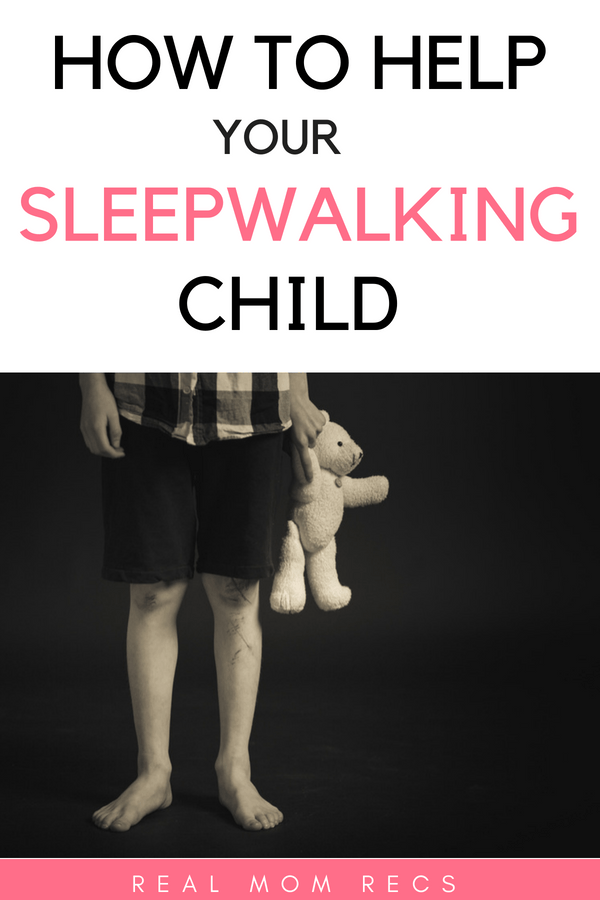Finding your child sleepwalking can be a scary event. You may feel like you’ll never be able to sleep soundly again for fear that your child will roam the house and get hurt.
Then there is the fear surrounding the unknowns of sleepwalking. For example, is it true that you shouldn’t wake a sleepwalker because it might lead to them having a heart attack, or it might cause brain damage?
While this is a myth, there is some truth to the notion that it’s best not to wake a sleepwalker. The best thing to do if you find your child sleepwalking is to gently guide them back to bed. If you try to wake them, they could become pretty distressed and even lash out at you in panic.
There is a risk of injury involved with sleepwalking, so how can you keep your child safe?
This post was written in collaboration with Sleep Advisor. All opinions are my own.
How to keep your sleepwalking child safe
Create a safe sleeping environment
Steer clear of low-hanging lights and make sure the space around the bed is clear so the sleepwalker doesn’t trip. Put any sharp or dangerous objects that your child could knock over or walk into.
(Keep in mind that sleepwalkers are usually dreaming and may act out what they’re dreaming. Make sure if the child tries to pick up a hairbrush from the bedside table, he won’t accidentally pick up a scissors instead!)
Also, be sure to lock all doors and windows before going to bed – you certainly don’t want the sleepwalker to be able to get outdoors.
Heavy drapes over the windows are a good call, too… this will save any punching fists or kicking feet smashing through the glass. (Ouch!)
Consider sleeping downstairs
Stairs can be dangers for small children even when they’re awake, so if your child sleepwalks, it’s best to take stairs out of the equation.
If you don’t have a secure gate at the top of the stairs, consider sleeping with your child in a downstairs room instead.
And if you have a basement, keep the door to that locked, too. Just closing the door is not enough, because a child that can open doors while awake is still able to open doors while sleepwalking.
Install an alarm
If your child is up and wandering in the house at night, you will want to know it’s happening. An alarm can alert you that your sleepwalker is up and about.
It doesn’t have to be a high-tech, heavy duty number. It can be a simple as a bell and string device, hung by the bedroom door, which rings should anyone try to venture out during the night.
This could get a little annoying during late-night bathroom breaks; but still, if it prevents your sleepwalking companion from traipsing around the house, it could be a good idea!
How to prevent your child from sleepwalking
So, these are some of the measures you can take to keep a sleepwalker safe. But is there anything you can do to prevent them from sleepwalking in the first place?
Turns out that yes, yes there are.
Get enough sleep
It might come as a surprise to you, but most children are not getting adequate sleep for optimal health and growth. Depending on age, your child needs between 9 and 14 hours of sleep in a 24 period.
For toddlers up to age 3 or 4, that typically includes night time sleep plus an afternoon nap.
It is extremely important for kids to have regular, consistent bedtimes and nap times so their body can form natural sleep rhythms and not fall into a pattern of fighting sleep due to over tiredness. Bed time should be when the child starts slowing down their activity level, not after they’ve fought fatigue and get an energy burst known as “a second wind”.
If you have an extremely early riser, check out this post to help them sleep until a normal hour.
If your child has a tendency to sleepwalk, try getting them to bed earlier and sleeping more. For tips on how to get a better snooze on, check out what the Sleep–Advisor has to say about it. Stay rested and who knows – those nocturnal wanders might come to an end.
Promote meditation and relaxation
One reason for sleepwalking can be stress or restlessness of the mind. And this happens to us all, including kids.
For sleepwalkers, this restlessness is happening on an entirely subconscious level. By doing specific exercises to calm the mind, they can achieve a deeper, better-quality sleep.
Even toddlers can learn “bubble breathing”, or long, slow breaths as if you’re blowing bubbles or blowing out birthday candles. This deep breathing helps calm the body, even if they think they’re just playing.
Keeping the lights low the stimulation mild for an hour before bed can help kids get into a more relaxed state as well. The typical bedtime routine of bath time and reading books is optimal for this.
Avoid stimulation before bed
This doesn’t have to be all the time – thankfully – just in the hour before bedtime. Watching TV, playing video games, or being on an iPad isn’t going to help your child sleep.
The thing is, just as the mind is meant to be settling down, the blue light that all those screens emit is sending it into overdrive. They will become more alert, more aware, and less inclined to sleep.
Plus, that hard-core action video game they played before bed might make a sleepwalker jump up in the night to save the day, and 2am stunts are never a good idea!
So sleep well… and sleep safely!
Hopefully these tips will help you to keep sleepwalking at bay, or at least to keep the sleepwalker free from harm. May tonight, and all the nights that follow, be as restful and as peaceful as possible.



